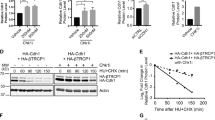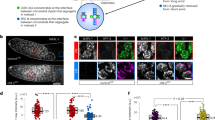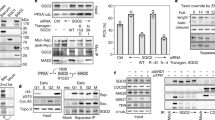Abstract
Sister-chromatid cohesion is established during S phase when Eco1 acetylates cohesin. In budding yeast, Eco1 activity falls after S phase due to Cdk1-dependent phosphorylation, which triggers ubiquitination by SCFCdc4. We show here that Eco1 degradation requires the sequential actions of Cdk1 and two additional kinases, Cdc7–Dbf4 and the GSK-3 homolog Mck1. These kinases recognize motifs primed by previous phosphorylation, resulting in an ordered sequence of three phosphorylation events on Eco1. Only the latter two phosphorylation sites are spaced correctly to bind Cdc4, resulting in strict discrimination between phosphates added by Cdk1 and by Cdc7. Inhibition of Cdc7 by the DNA damage response prevents Eco1 destruction, allowing establishment of cohesion after S phase. This elaborate regulatory system, involving three independent kinases and stringent substrate selection by a ubiquitin ligase, enables robust control of cohesion establishment during normal growth and after stress.
This is a preview of subscription content, access via your institution
Access options
Subscribe to this journal
Receive 12 print issues and online access
$189.00 per year
only $15.75 per issue
Buy this article
- Purchase on Springer Link
- Instant access to full article PDF
Prices may be subject to local taxes which are calculated during checkout







Similar content being viewed by others
References
Holt, L.J. et al. Global analysis of Cdk1 substrate phosphorylation sites provides insights into evolution. Science 325, 1682–1686 (2009).
Ubersax, J.A. et al. Targets of the cyclin-dependent kinase Cdk1. Nature 425, 859–864 (2003).
Petroski, M.D. & Deshaies, R.J. Function and regulation of cullin-RING ubiquitin ligases. Nat. Rev. Mol. Cell Biol. 6, 9–20 (2005).
Welcker, M. & Clurman, B.E. FBW7 ubiquitin ligase: a tumour suppressor at the crossroads of cell division, growth and differentiation. Nat. Rev. Cancer 8, 83–93 (2008).
Nash, P. et al. Multisite phosphorylation of a CDK inhibitor sets a threshold for the onset of DNA replication. Nature 414, 514–521 (2001).
Hao, B., Oehlmann, S., Sowa, M.E., Harper, J.W. & Pavletich, N.P. Structure of a Fbw7-Skp1-Cyclin E Complex: Multisite-Phosphorylated Substrate Recognition by SCF Ubiquitin Ligases. Mol. Cell 26, 131–143 (2007).
Bao, M.Z., Shock, T.R. & Madhani, H.D. Multisite phosphorylation of the Saccharomyces cerevisiae filamentous growth regulator Tec1 is required for its recognition by the E3 ubiquitin ligase adaptor Cdc4 and its subsequent destruction in vivo. Eukaryot. Cell 9, 31–36 (2010).
Welcker, M. & Clurman, B.E. Fbw7/hCDC4 dimerization regulates its substrate interactions. Cell Div. 2, 7 (2007).
Tang, X. et al. Suprafacial orientation of the SCFCdc4 dimer accommodates multiple geometries for substrate ubiquitination. Cell 129, 1165–1176 (2007).
Lyons, N.A. & Morgan, D.O. Cdk1-dependent destruction of Eco1 prevents cohesion establishment after S phase. Mol. Cell 42, 378–389 (2011).
Rolef Ben-Shahar, T. et al. Eco1-dependent cohesin acetylation during establishment of sister chromatid cohesion. Science 321, 563–566 (2008).
Rowland, B.D. et al. Building sister chromatid cohesion: smc3 acetylation counteracts an antiestablishment activity. Mol. Cell 33, 763–774 (2009).
Sutani, T., Kawaguchi, T., Kanno, R., Itoh, T. & Shirahige, K. Budding yeast Wpl1(Rad61)-Pds5 complex counteracts sister chromatid cohesion-establishing reaction. Curr. Biol. 19, 492–497 (2009).
Unal, E. et al. A molecular determinant for the establishment of sister chromatid cohesion. Science 321, 566–569 (2008).
Ström, L. et al. Postreplicative formation of cohesion is required for repair and induced by a single DNA break. Science 317, 242–245 (2007).
Ström, L., Lindroos, H.B., Shirahige, K. & Sjogren, C. Postreplicative recruitment of cohesin to double-strand breaks is required for DNA repair. Mol. Cell 16, 1003–1015 (2004).
Unal, E., Heidinger-Pauli, J.M. & Koshland, D. DNA double-strand breaks trigger genome-wide sister-chromatid cohesion through Eco1 (Ctf7). Science 317, 245–248 (2007).
Sjögren, C. & Nasmyth, K. Sister chromatid cohesion is required for postreplicative double-strand break repair in Saccharomyces cerevisiae. Curr. Biol. 11, 991–995 (2001).
Heidinger-Pauli, J.M., Unal, E., Guacci, V. & Koshland, D. The kleisin subunit of cohesin dictates damage-induced cohesion. Mol. Cell 31, 47–56 (2008).
Heidinger-Pauli, J.M., Unal, E. & Koshland, D. Distinct targets of the Eco1 acetyltransferase modulate cohesion in S phase and in response to DNA damage. Mol. Cell 34, 311–321 (2009).
Kinoshita, E., Kinoshita-Kikuta, E., Takiyama, K. & Koike, T. Phosphate-binding tag, a new tool to visualize phosphorylated proteins. Mol. Cell. Proteomics 5, 749–757 (2006).
Cho, W.H., Lee, Y.J., Kong, S.I., Hurwitz, J. & Lee, J.K. CDC7 kinase phosphorylates serine residues adjacent to acidic amino acids in the minichromosome maintenance 2 protein. Proc. Natl. Acad. Sci. USA 103, 11521–11526 (2006).
Masai, H. et al. Human Cdc7-related kinase complex. In vitro phosphorylation of MCM by concerted actions of Cdks and Cdc7 and that of a criticial threonine residue of Cdc7 bY Cdks. J. Biol. Chem. 275, 29042–29052 (2000).
Mok, J. et al. Deciphering protein kinase specificity through large-scale analysis of yeast phosphorylation site motifs. Sci. Signal. 3, ra12 (2010).
Randell, J.C. et al. Mec1 is one of multiple kinases that prime the Mcm2–7 helicase for phosphorylation by Cdc7. Mol. Cell 40, 353–363 (2010).
Oshiro, G., Owens, J.C., Shellman, Y., Sclafani, R.A. & Li, J.J. Cell cycle control of Cdc7p kinase activity through regulation of Dbf4p stability. Mol. Cell. Biol. 19, 4888–4896 (1999).
Sullivan, M., Holt, L. & Morgan, D.O. Cyclin-specific control of ribosomal DNA segregation. Mol. Cell. Biol. 28, 5328–5336 (2008).
Labib, K. How do Cdc7 and cyclin-dependent kinases trigger the initiation of chromosome replication in eukaryotic cells? Genes Dev. 24, 1208–1219 (2010).
Marston, A.L. Meiosis: DDK is not just for replication. Curr. Biol. 19, R74–R76 (2009).
Jackson, A.L., Pahl, P.M., Harrison, K., Rosamond, J. & Sclafani, R.A. Cell cycle regulation of the yeast Cdc7 protein kinase by association with the Dbf4 protein. Mol. Cell. Biol. 13, 2899–2908 (1993).
Doble, B.W. & Woodgett, J.R. GSK-3: tricks of the trade for a multi-tasking kinase. J. Cell Sci. 116, 1175–1186 (2003).
Fiol, C.J., Mahrenholz, A.M., Wang, Y., Roeske, R.W. & Roach, P.J. Formation of protein kinase recognition sites by covalent modification of the substrate. Molecular mechanism for the synergistic action of casein kinase II and glycogen synthase kinase 3. J. Biol. Chem. 262, 14042–14048 (1987).
Xu, C., Kim, N.G. & Gumbiner, B.M. Regulation of protein stability by GSK3 mediated phosphorylation. Cell Cycle 8, 4032–4039 (2009).
Kassir, Y., Rubin-Bejerano, I. & Mandel-Gutfreund, Y. The Saccharomyces cerevisiae GSK-3 beta homologs. Curr. Drug Targets 7, 1455–1465 (2006).
Mizunuma, M., Hirata, D., Miyaoka, R. & Miyakawa, T. GSK-3 kinase Mck1 and calcineurin coordinately mediate Hsl1 down-regulation by Ca2+ in budding yeast. EMBO J. 20, 1074–1085 (2001).
Kishi, T., Ikeda, A., Nagao, R. & Koyama, N. The SCFCdc4 ubiquitin ligase regulates calcineurin signaling through degradation of phosphorylated Rcn1, an inhibitor of calcineurin. Proc. Natl. Acad. Sci. USA 104, 17418–17423 (2007).
Ikui, A.E., Rossio, V., Schroeder, L. & Yoshida, S. A yeast GSK-3 kinase Mck1 promotes Cdc6 degradation to inhibit DNA re-replication. PLoS Genet. 8, e1003099 (2012).
Kõivomägi, M. et al. Cascades of multisite phosphorylation control Sic1 destruction at the onset of S phase. Nature 480, 128–131 (2011).
Tang, X. et al. Composite low affinity interactions dictate recognition of the cyclin-dependent kinase inhibitor Sic1 by the SCFCdc4 ubiquitin ligase. Proc. Natl. Acad. Sci. USA 109, 3287–3292 (2012).
Liu, Q. et al. SCFCdc4 enables mating type switching in yeast by cyclin-dependent kinase-mediated elimination of the Ash1 transcriptional repressor. Mol. Cell. Biol. 31, 584–598 (2011).
Kihara, M. et al. Characterization of the yeast Cdc7p/Dbf4p complex purified from insect cells. Its protein kinase activity is regulated by Rad53p. J. Biol. Chem. 275, 35051–35062 (2000).
Weinreich, M. & Stillman, B. Cdc7p-Dbf4p kinase binds to chromatin during S phase and is regulated by both the APC and the RAD53 checkpoint pathway. EMBO J. 18, 5334–5346 (1999).
Lei, M. et al. Mcm2 is a target of regulation by Cdc7-Dbf4 during the initiation of DNA synthesis. Genes Dev. 11, 3365–3374 (1997).
Gabrielse, C. et al. A Dbf4p BRCA1 C-terminal-like domain required for the response to replication fork arrest in budding yeast. Genetics 173, 541–555 (2006).
Takeda, T. et al. Regulation of initiation of S phase, replication checkpoint signaling, and maintenance of mitotic chromosome structures during S phase by Hsk1 kinase in the fission yeast. Mol. Biol. Cell 12, 1257–1274 (2001).
Lopez-Mosqueda, J. et al. Damage-induced phosphorylation of Sld3 is important to block late origin firing. Nature 467, 479–483 (2010).
Zegerman, P. & Diffley, J.F. Checkpoint-dependent inhibition of DNA replication initiation by Sld3 and Dbf4 phosphorylation. Nature 467, 474–478 (2010).
Mantiero, D., Mackenzie, A., Donaldson, A. & Zegerman, P. Limiting replication initiation factors execute the temporal programme of origin firing in budding yeast. EMBO J. 30, 4805–4814 (2011).
Tanaka, S., Nakato, R., Katou, Y., Shirahige, K. & Araki, H. Origin association of Sld3, Sld7, and Cdc45 proteins is a key step for determination of origin-firing timing. Curr. Biol. 21, 2055–2063 (2011).
Longtine, M.S. et al. Additional modules for versatile and economical PCR-based gene deletion and modification in Saccharomyces cerevisiae. Yeast 14, 953–961 (1998).
Wolters, D.A., Washburn, M.P. & Yates, J.R. III. An automated multidimensional protein identification technology for shotgun proteomics. Anal. Chem. 73, 5683–5690 (2001).
Fonslow, B.R. et al. Single-step inline hydroxyapatite enrichment facilitates identification and quantitation of phosphopeptides from mass-limited proteomes with MudPIT. J. Proteome Res. 11, 2697–2709 (2012).
Cociorva, D., Tabb, D.L. & Yates, J.R. Validation of tandem mass spectrometry database search results using DTASelect. Curr Protoc Bioinformatics Chapter 13, Unit 13 4 (2007).
Tabb, D.L., McDonald, W.H. & Yates, J.R. III. DTASelect and Contrast: tools for assembling and comparing protein identifications from shotgun proteomics. J. Proteome Res. 1, 21–26 (2002).
Schroeder, M.J., Shabanowitz, J., Schwartz, J.C., Hunt, D.F. & Coon, J.J. A neutral loss activation method for improved phosphopeptide sequence analysis by quadrupole ion trap mass spectrometry. Anal. Chem. 76, 3590–3598 (2004).
Breci, L.A., Tabb, D.L., Yates, J.R. III & Wysocki, V.H. Cleavage N-terminal to proline: analysis of a database of peptide tandem mass spectra. Anal. Chem. 75, 1963–1971 (2003).
Courcelles, M., Bridon, G., Lemieux, S. & Thibault, P. Occurrence and detection of phosphopeptide isomers in large-scale phosphoproteomics experiments. J. Proteome Res. 11, 3753–3765 (2012).
Loog, M. & Morgan, D.O. Cyclin specificity in the phosphorylation of cyclin-dependent kinase substrates. Nature 434, 104–108 (2005).
Acknowledgements
We thank S. Bell (Massachusetts Institute of Technology, Cambridge, Massachusetts, USA), D. Toczyski (University of California, San Francisco, California, USA), H. Madhani (University of California, San Francisco, California, USA) and K. Shokat (University of California, San Francisco, California, USA) for strains and reagents, M. Loog for advice with kinase assays, A. Ikui for discussion of unpublished results, J. Wohlschlegel for advice with mass spectrometry, J. Mugridge for assistance with fluorescence anisotropy and E. Edenberg and S. Foster for critical review of the manuscript. This work was supported by funding from the US National Institute of General Medical Sciences (R01-GM069901 to D.O.M. and P41-GM103533 to J.R.Y.) and the National Center for Research Resources (P41-RR011823 to J.R.Y.).
Author information
Authors and Affiliations
Contributions
N.A.L. and D.O.M. conceived the experiments, N.A.L. conducted the biological and biochemical experiments, B.R.F. performed mass spectrometry, and B.R.F. and J.K.D. analyzed mass spectra under the guidance of J.R.Y. N.A.L. and D.O.M. wrote the manuscript.
Corresponding author
Ethics declarations
Competing interests
The authors declare no competing financial interests.
Supplementary information
Supplementary Text and Figures
Supplementary Figures 1 and 2 and Supplementary Tables 1 and 2 (PDF 449 kb)
Rights and permissions
About this article
Cite this article
Lyons, N., Fonslow, B., Diedrich, J. et al. Sequential primed kinases create a damage-responsive phosphodegron on Eco1. Nat Struct Mol Biol 20, 194–201 (2013). https://doi.org/10.1038/nsmb.2478
Received:
Accepted:
Published:
Issue Date:
DOI: https://doi.org/10.1038/nsmb.2478
This article is cited by
-
Redundant targeting of Isr1 by two CDKs in mitotic cells
Current Genetics (2021)
-
Exploring cyclic networks of multisite modification reveals origins of information processing characteristics
Scientific Reports (2020)
-
Multisite phosphorylation code of CDK
Nature Structural & Molecular Biology (2019)
-
Intrinsically disordered proteins in cellular signalling and regulation
Nature Reviews Molecular Cell Biology (2015)
-
Multisite phosphorylation networks as signal processors for Cdk1
Nature Structural & Molecular Biology (2013)



